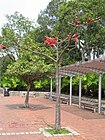Bombax ceiba
| Cotton tree | |
|---|---|

| |
| A Cotton Tree seen here at Hong Kong, China with flowers which bloom from February to April | |
| Scientific classification | |
| Kingdom: | |
| (unranked): | |
| (unranked): | |
| (unranked): | |
| Order: | |
| Family: | |
| Genus: | |
| Species: | B. ceiba
|
| Binomial name | |
| Bombax ceiba | |
| Synonyms | |
|
Bombax malabaricum DC. | |
Bombax ceiba, like other trees of the genus Bombax, is commonly known as cotton tree. This tropical tree has a straight tall trunk and its leaves are deciduous in winter. Red flowers with 5 petals appear in the spring before the new foliage. It produces a capsule which, when ripe, contains white fibres like cotton. Its trunk bears spikes to deter attacks by animals. Although its stout trunk suggests that it is useful for timber, its wood is too soft to be very useful.
The dry cores of the Bombax ceiba flower (Thai: งิ้ว)[1] are an essential ingredient of the Nam ngiao spicy noodle soup of the cuisine of Shan State and Northern Thailand,[2] as well as the Kaeng khae curry.[3]
Description
Bombax ceiba grows to an average of 20 meters, with old trees up to 60 meters in wet tropical weather. The trunk and limb bear numerous conical spines particularly when young, but get eroded when older. The leaves are palmate with about 6 leaflets radiating from a central point, an average of 7~10 centimeters wide, 13~15 centimeters in length. The leaf's long flexible petiole is up to 20 cm long.
Cup-shaped Flowers solitary or clustered, axillary or sub-terminal, fascicles at or near the ends of the branches, when the tree is bare of leaves, an average of 7~11 centimeters wide, 14 centimeters in width, petels up to 12 centimeters in length, Calyx is cup-shaped usually 3 lobed, an average of 3~5 centimeters in diameter. Staminal tube is short, more than 60 in 5 bundles. Stigma is light red, up to nine centimeters in length, Ovary is pink, 1.5~ 2 centimeters in length, with the skin of the Ovary covered in white silky hair at 1mm long. Seeds are numerous, long, ovoid, black or gray in colour and packed in white cotton.

The fruit, which reaches an average of 13 centimeters in length, is light-green in color in immature fruits, brown in mature fruits.
Cultivation
The tree is widely planted in Malay, Indonesia, south China, Hong Kong and Taiwan. According to Chinese historical record, the king of Nam Yuet, Chiu To, gave a tree to the Emperor of Han dynasty in 2nd century BC.
This tree is commonly known as Semal (Hindi: सेमल) or Shimul (Bengali: শিমুল) in India. It is widely planted in parks and on roadsides there because of its beautiful red flowers which bloom in March/April. This tree is quite common in New Delhi although it doesn't reach its full size of 60m there because of the semi arid climate. The cotton fibers of this tree can be seen floating in the wind around the time of early May. This tree shows two marked growth sprints in India- in spring and during the monsoon months.
This tree is also found in the eastern parts of Pakistan, especially in the eastern city of Lahore. The local Urdu and Punjabi name for the tree is 'Sumbal'.
It is widely planted Hong Kong, and is know locally as 木棉花 in Chinese. This tree is evenly planted across Hong Kong, with some trees flowering from late February to early May. Fruiting can start as early as March. At the peak of the Bombax ceiba flowering season in Hong Kong, elderly people could often be found picking flowers off the ground to dry, which is used to make a type of tea. The flowers are very attractive to local wildlife, with many birds like the Japanese White-eye, a type of fruit eating bird, which often draws a hole in an unopened Bombax ceiba flower bud. Honey bees, and bumble bees also attracted to the flowers to collect pollen and nectar. Because the flowers attract many insects, Crab Spiders can be occasionally found on a fully opened flower, hunting bees.

Gallery
-
Young Tree flowering in Shing Mun River, Shatin, Hong Kong.
-
Bombax-ceiba seedling growing in a seed pod in Hong Kong.
-
Not all Bombax-ceiba flowers are red. This is an orange flowered variety.
-
Up close of a Bombax-ceiba flower, showing nectar inside the flower.








